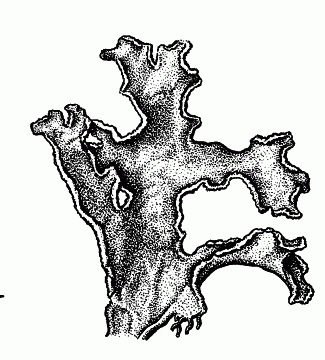Tuckermannopsis chlorophylla (Willd. in Humb.) Vainio
Silver-lined wrinkle
Parmeliaceae
Introduction to the Lichens
Silver-lined wrinkle
Parmeliaceae
Introduction to the Lichens
Map
Distribution of Tuckermannopsis chlorophylla unavailable
Species Information
General:
Common Names: The Icelandmoss Lichens (and others). Several are assigned to this genus, reflecting its very heterogeneous circumscription: “Brown” is applied to two species (C. commixta and C. hepatizon), stressing their surface colour and, more importantly, their generic similarity with other lichens of that name (i.e., members of Melanelia and Neofuscelia). “Icelandmoss” is the traditional name given to Cetraria islandica and its allies. “Paperdoll” is a fanciful name applied to two species (C. cucullata and C. nivalis), referring to their pale, upright, “cut-out” lobes. “Ruffle” is applied to several species, describing their typically wrinkled upper surface. “Thornbush” is applied to two species (C. californica and C. merrillii), conveying their spiny, shrub-like habit.
Small to large stratified foliose lichens, corticate above and below, sorediate or not, lobes rather closely appressed to semi-erect or erect, short to more often elongate, averaging to 0.5–10 (–12) mm wide, thin to somewhat thick, occasionally bearing protruberant marginal pycnidia or cilia. Upper surface brownish, blackish, or brightly coloured; lower surface coloured alike with upper surface, often lacking rhizines. Medulla white (rarely yellow). Photobiont green.
Apothecia located along lobe margins, disc brown or black; spores simple, spherical or ellipsoid, colourless, 8 per ascus.
Notes: Thirty-eight species of Cetraria are reported for North America. Nineteen of these occur in B.C. As presently delimited, Cetraria is a heterogeneous genus. Although several species groups are segregated from it as distinct genera (e.g. Asahinea, Cetrelia, Esslingeriana, Masonhalea, Platismatia and Vulpicida), a number of other species and species groups also deserve generic rank. Recently Hale (1987) transfered some of these to Tuckermannopsis. This disposition, however, seems more nomenclatural than taxonomic and is not followed here. Also not accepted here (pending further study) is the separate genus Allocetraria (Randlane and Saag 1992).
Species description:
Upper surface essentially dark: olive-green, brown or blackish AND
Soredia present, located along margins of lobes, occasionally intermixed with isidia
Reactions:
Medulla KC+ reddish, UV+ white.
Contents:
Alectoronic and alpha-collatolic acids.
Source: Lichens of British Columbia
Illustration

If more than one illustration is available for a species (e.g., separate illustrations were provided for two subspecies) then links to the separate images will be provided below. Note that individual subspecies or varietal illustrations are not always available.
Illustration By: Trevor Goward
Habitat and Range
Habitat: Common over coniferous and deciduous trees and shrubs in open to shaded forests throughout, except probably absent from boreal regionsWorld Distribution: incompletely circumpolar, N to AK, S to CA.
Source: Lichens of British Columbia